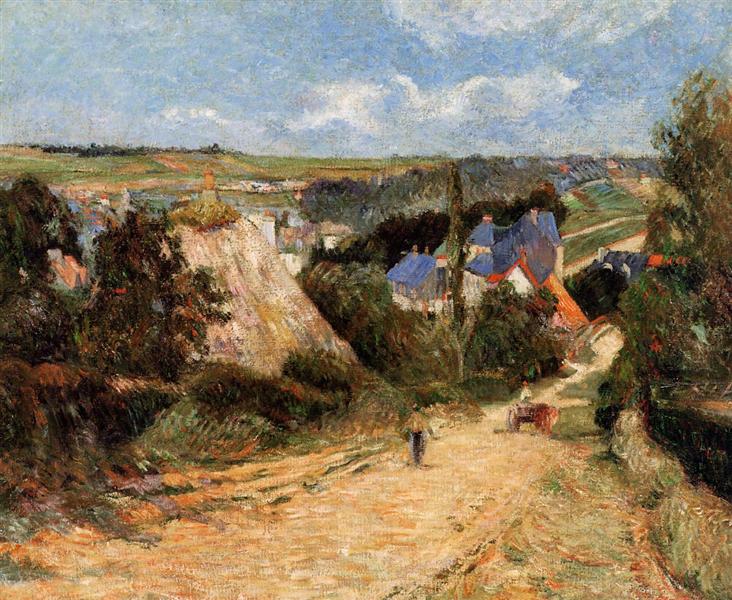Description
Paul Gauguin's "Street at Osny" (1883) is an early reflection of the stylistic and thematic developments that would mark his later development as one of the most influential artists of Post-Impressionism. In this work, Gauguin gradually moved away from the subtle palettes and techniques of Impressionism, moving towards a more personal and symbolic approach in his interpretation of reality.
The painting captures a quiet scene on a street in Osny, a small town near Paris. The composition is rectilinear, leading the viewer's eye along the road that meanders into the horizon. The use of perspective is simple, but effective, creating a sense of depth that invites one to explore every part of the work. The houses with simple facades are presented with an almost childlike geometry, evoking the simplicity of rural life. This stylistic choice is representative of Gauguin's search for a more direct and less "artificial" form of art, one that connects with the roots of human experience.
The treatment of color in “Street at Osny” is equally significant. Gauguin uses a palette of vibrant and contrasting colors, dominated by deep greens, warm ochres and earth tones that highlight the lushness of the surrounding nature. This use of color not only sets the mood of the scene, but also suggests an emotional symbolism that goes beyond mere representation. The way the colors interact manages to achieve a kind of visual synesthesia, inviting interpretation and emotion.
In the work, the presence of human figures is minimal; Gauguin opts for a more abstract representation of everyday life. The absence of visible characters can be interpreted as a contemplation on solitude and introspection, recurring themes in his later work. This feature also allows the viewer's attention to focus on the surroundings, fostering a deeper connection with nature, which Gauguin considered essential in his artistic quest.
"Street in Osny" is set in a context where Impressionism and Post-Impressionism intertwine, and can be seen as a precursor to the bolder works that would come in his career, where he would experiment more radically with color and form. Gauguin's work is distinguished by its rejection of traditional representation and its inclination towards the symbolic, aspects that would later become even more evident in his explorations in Tahiti, where cultural influences and local myths would intertwine with his own artistic vision.
In short, "Street in Osny" is a key piece that allows us to glimpse Gauguin's first steps towards an art that not only represents, but evokes. The work is an invitation to reflect on the meaning of everyday life and to appreciate the beauty in simplicity, serving as a compass towards his evolution and future explorations in art. Through this work, Gauguin shows us not only a street in a village, but a path towards his own inner truth and, by extension, to the universal human experience.
KUADROS ©, a famous painting on your wall.
Hand-made oil painting reproductions, with the quality of professional artists and the distinctive seal of KUADROS ©.
Painting reproduction service with satisfaction guarantee. If you are not completely satisfied with the replica of your painting, we will refund 100% of your money.

